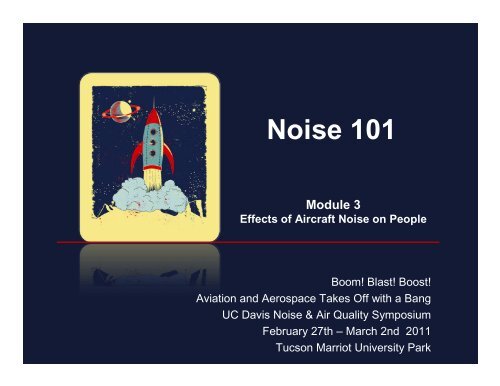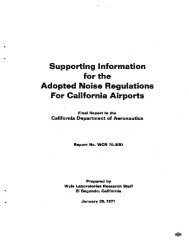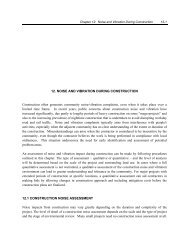Noise 101, Module 3 - HMMH
Noise 101, Module 3 - HMMH
Noise 101, Module 3 - HMMH
Create successful ePaper yourself
Turn your PDF publications into a flip-book with our unique Google optimized e-Paper software.
<strong>Noise</strong> <strong>101</strong><br />
<strong>Module</strong> 3<br />
Effects of Aircraft <strong>Noise</strong> on People<br />
Boom! Blast! Boost!<br />
Aviation and Aerospace Takes Off with a Bang<br />
UC Davis <strong>Noise</strong> & Air Quality Symposium<br />
February 27th – March 2nd 2011<br />
Tucson Marriot University Park
Effects of Aircraft <strong>Noise</strong> on<br />
People<br />
• Health Effects<br />
– Hearing loss<br />
– Cardiovascular<br />
– Other physiological effects<br />
• Annoyance<br />
• Activity Interference<br />
– Speech interference<br />
– Sleep interference<br />
– Children’s learning<br />
• Ongoing research<br />
– FAA <strong>Noise</strong> Research Roadmap<br />
– ACRP
<strong>Noise</strong>-Induced Hearing<br />
Loss<br />
• Temporary threshold shift (TTS)<br />
– Caused by prolonged high exposure<br />
– Ear will usually recover overnight<br />
• <strong>Noise</strong>-induced permanent threshold shift (NIPTS)<br />
– Repeated prolonged exposure can result in permanent damage<br />
• OSHA standards: 90 dB for 8 hours<br />
– Would require thousands of loud overflights per hour<br />
• Risk of hearing loss due to community exposure to<br />
aircraft noise is very low
Hearing Loss in Children<br />
• Centers for Disease Control, National Center for Health<br />
Statistics, Third National Health and Nutrition<br />
Examination Survey (NHANES), 1988-1994, included<br />
questions related to hearing loss<br />
• Prevalence of hearing loss in children as high as 15%,<br />
– Generally in frequency range of 3- to 6 KHz<br />
– Generally only one ear<br />
• Potential causes:<br />
– Personal audio devices<br />
– Noisy toys
Non-Auditory Health<br />
Effects<br />
• Non-auditory health<br />
effects claims are difficult<br />
to prove or disprove:<br />
– Cardio-vascular<br />
– Hypertension<br />
– Mental health<br />
• Recent studies:<br />
– HYENA<br />
– Cologne-Bonn Airport<br />
Study Source: HYENA, 2008
Annoyance<br />
• Schultz developed accepted “dose-response”<br />
relationship in 1970s. FICON re-affirmed, 1992<br />
Source: FICON, 1992
Annoyance<br />
• Recent analysis focused on different sources
Relationship of DNL to<br />
%HA<br />
• Are people becoming more noise-sensitive?
Relationship of DNL to<br />
%HA<br />
• Are people becoming more noise-sensitive?
Speech Interference<br />
Source: US EPA, “Information on Levels of <strong>Noise</strong> Requisite to Protect the<br />
Public Health and Welfare with an Adequate Margin of Safety”, March 1974,<br />
Washington, D.C., 1973, p. D-5
FICON / FICAN Sleep<br />
Disturbance Dose-Response<br />
Recommendations<br />
Source: FICAN, 1997
FICAN: Awakenings<br />
Recommendations<br />
• ANSI Standard S12.9-2008, Quantities<br />
and Procedures for Description and<br />
Measurement of Environmental Sound —<br />
Part 6: Methods for Estimation of<br />
Awakenings Associated with Outdoor<br />
<strong>Noise</strong> Events Heard in Homes<br />
• Predicts % Awakening from an entire<br />
night’s operation<br />
• Can be derived from INM results
Effects of Aircraft <strong>Noise</strong><br />
on Children’s Learning<br />
• Speech: Potential delays in language acquisition<br />
• Reading: Studies suggest effect on test scores<br />
• Motivation: “Learned helplessness”<br />
• Memory: Some studies suggest memory deficits
FAA <strong>Noise</strong> Research<br />
Roadmap<br />
1. <strong>Noise</strong> effects on health and welfare<br />
– Update basis for establishing significant<br />
impact<br />
– Potential health & welfare impact in areas<br />
considered noise-compatible<br />
2. <strong>Noise</strong> in National Parks and<br />
wilderness<br />
– Impacts to national parks and wilderness<br />
areas<br />
– Aircraft operations above 18,000 feet AGL
FAA <strong>Noise</strong> Research<br />
Roadmap<br />
3. NextGen noise modeling<br />
enhancements<br />
– Other operational regimes<br />
– Unconventional aircraft<br />
4. Overall costs of aircraft noise on<br />
society<br />
– in common currency with other environmental<br />
costs for informed decision-making
ACRP Projects dealing with<br />
<strong>Noise</strong> Effects<br />
• 02-26: Assessing Aircraft <strong>Noise</strong><br />
Conditions Affecting Student Learning<br />
• 02-35: Research Methods for<br />
Understanding Aircraft <strong>Noise</strong> Annoyance<br />
and Sleep Disturbance
• Status:<br />
ACRP 02-26 Assessing Aircraft<br />
<strong>Noise</strong> Conditions Affecting Student<br />
Learning<br />
– Underway, completion in 2011-2012<br />
• Objectives:<br />
– Identify and evaluate conditions under which<br />
aircraft noise affects student learning<br />
– Identify and evaluate one or more alternative<br />
noise metrics that best define those<br />
conditions
• Status:<br />
ACRP 02-35 Research Methods for<br />
Understanding Aircraft <strong>Noise</strong><br />
Annoyance and Sleep Disturbance<br />
– Request for proposals out; due 3/22<br />
• Objectives:<br />
– Develop and validate a research protocol for a largescale<br />
study of aircraft noise exposure-annoyance<br />
response relationships across the U.S.<br />
– Propose alternative research methods for field<br />
studies to assess the relationship between aircraft<br />
noise and sleep disturbance for U.S. airports
Must-have References<br />
• ACRP Synthesis 9, Effects of Aircraft <strong>Noise</strong>:<br />
Research Update on Selected Topics<br />
• Federal Interagency Committee on <strong>Noise</strong><br />
(“FICON”), “Federal Agency Review of Selected<br />
Airport <strong>Noise</strong> Analysis Issues”, August 1992<br />
• US EPA, “Information on Levels of <strong>Noise</strong><br />
Requisite to Protect Public Health and Welfare<br />
with an Adequate Margin of Safety”, March<br />
1974<br />
• www.fican.org








